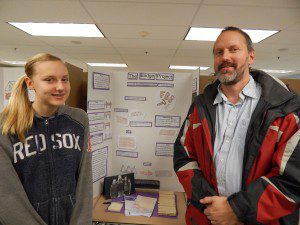HUNTINGTON – Eighth grade students at Gateway Regional Jr. High School have just completed a hands-on project that blended a study of the local Keystone Arch Bridges with research on the history of the hilltowns and an engineering study of bridge building. They presented their results to their families at a special exhibition on November 20.
A small group of students presented their research to the Board of the Gateway Education Foundation at their November 18 meeting. The Gateway Education Foundation helped to fund the study through its Funds For Learning program. The foundation’s biggest fundraiser to support programs like this will take place on Valley Gives Day – 12/12/13. Donors may make online donations to the Gateway Education Foundation at www.valleygivesday.org on that date to make a donation.
The project began earlier this fall during social studies class, with students learning about keystone bridge work in Ireland and the recruitment of Irish laborers to build roads and bridges in America. Dennis Picard, a historic reenactor from Storrowtown Village visited the school to demonstrate the tools and techniques that were used to build the Keystone Bridges for the Western Railroad, which later became the Boston & Albany Railroad.
Students then spent a day hiking to the bridges, which are listed on the National Register of Historic Places, and visiting the Chester Railway Station where they learned about the construction and operations of the Boston& Albany Railroad from Chester Foundation President Dave Pierce. Students learned that the line that passes through the Gateway hilltowns of Russell, Huntington, Chester and Middlefield was the first mountain railroad constructed in the world.
Students also formed groups to study the history of the town that they live in. The history of the towns of Blandford, Chester, Huntington, Middlefield, Montgomery, Russell and Worthington were compiled into i-Movies, complete with original and historic photos that were set to music, by each team.
Meanwhile, in science class, eighth grade students formed small working groups to use the Engineering Design Process in the study of different bridge designs. The process involves defining a problem, conducting research, brainstorming solutions, building, testing/evaluating and communicating on a design, and then redesigning the model as necessary. Students studied various types of bridges, researched efficiency loads and materials, and kept individual journals about their findings. Each group was given 200 Popsicle sticks and glue, with an assignment to select and build the design that they believed would hold the most weight. Finished bridges were put to the test in class, with some breaking and others holding up to maximum load of 95 pounds. Each working group shared their individual journals with their group exhibit about their design theories and findings.
Science teacher Patricia Diefendorf was pleased with the student projects. “The kids had so much fun learning about bridges, I’m planning another project—somewhere on Mars…” she joked.
Families were invited to attend a showcase of student work on November 20th. They gathered in the Jr. High’s Community Room to see a film on how the Key Stone Arches were constructed and to learn more about the entire unit of study. From there, students and parents toured the engineering project displays, which outlined the Engineering Design Process for each team, individual journals and their finished bridges.
Families then travelled to a classroom that was showing the student-made movies on the history of their hilltown.
The week of Thanksgiving, students will have a “Build ‘Em, Bust ‘Em” contest to test how much weight each bridge will hold before it breaks. In preliminary tests, some bridges had held the maximum weight available (95 pounds) with room for more weight.


